
RAFAL GERSZAK FOR THE GLOBE AND MAIL
In the social-media-fuelled world of ethical eating, feelings often trump facts, and buzzy terms like 'free-range' may not mean what you think. Ann Hui reports
Last September, the world's biggest burger chain announced that it wants the 120 million eggs used each year in Egg McMuffins and other breakfast items in Canada to come exclusively from hens not confined to a cage.
The news came as a surprise not only to competitors of McDonald's but to some who work for the company, too. It also had a cascading effect. In the months since, almost every major fast-food chain in North America has made a similar pledge to go cage-free.
In October, it was Starbucks. In December, Subway. In January, Wendy's. Even Tim Hortons followed suit: Back in 2012, it had vowed to source more eggs from hens in "furnished cages," which are bigger and nicer than the infamous "battery" type used for 90 per cent of the 40 million boxes of eggs produced in Canada every year. But then Tims changed owners – and its mind. In February, its parent company, which also owns Burger King, announced that both would go entirely cage-free.
What was behind the fight for feathered freedom? The short answer: public opinion and pressure. With the power of social media and the Internet, activists and animal-rights groups have gained unprecedented influence in shaping peoples' perceptions and decisions of what to eat. And the food industry has taken notice.
A&W Canada, too, has abandoned its pledge to use eggs from furnished cages – but only after being subjected to an extensive campaign. Like those other fast-food companies, it will move away from cages of any kind, no matter their size or amenities.
And yet, the theory behind the public pressure is that chickens, and all the animals we eat, deserve a better life – and that the best of all possible worlds for them would be one without cages.
Which may not be true.
Egg farmer Roger Pelissero on why he resists going cage-free for his hens
0:58
'It was a marketing decision'
The day before McDonald's made its announcement, the company called Temple Grandin.
The petite 60-something with curly grey hair has been a household name ever since the airing of the award-winning eponymous 2010 biopic starring Claire Danes. As well as being an icon in the world of autism – a condition she lives with – Dr. Grandin is the world's most influential expert on animal welfare.
Since teaming up with McDonald's back in 1997, she has helped to put in place policies to reduce anxiety and stress in the lives of creatures destined to become the hamburgers and Chicken McNuggets served to tens of millions of customers around the world each day. The company has even featured her in promotional materials to tout its advancements in animal welfare.
Her modus operandi is practicality – presenting McDonald's and other companies with specific, implementable recommendations, such as a checklist of welfare indicators: Are animals slipping and falling? Are they being poked in sensitive areas? And her signature innovations – such as designing curved corrals for cattle to walk in as they're led to slaughter, to reduce their ability to see what's coming – can be found in processing plants across North America.
So, it wasn't surprising for her to receive the call from McDonald's last September – but this time she wasn't being asked for an opinion. "Our science-based welfare committee did not make that decision" to go cage-free, she explained earlier this year while at the University of Guelph, to speak at a conference. "It was a marketing decision."
Rather than science alone, says Jill Manata, the company's vice-president of global public affairs, McDonald's had based its move on "our values as a company, what our customers are expecting" and "the marketplace." Still, she says the company did consult its animal-welfare council, but just the experts specifically focused on poultry; Dr. Grandin focuses mostly on cattle.
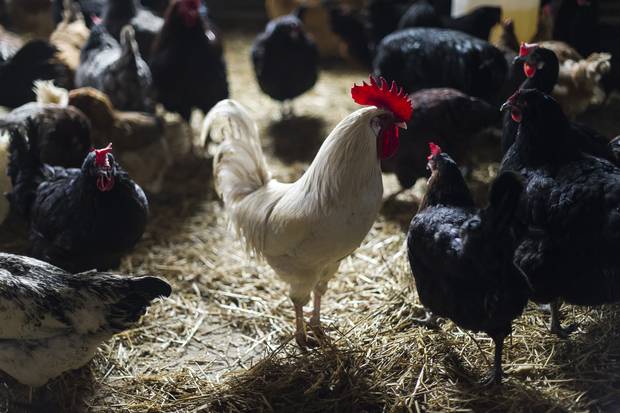
CHRISTOPHER KATSAROV FOR THE GLOBE AND MAIL
Facts and feelings
Now more than ever, what customers are expecting is for giant food companies like McDonald's to take steps to ensure the humane treatment of animals. The rise of social media and the cellphone camera has allowed activists for such groups as People for the Ethical Treatment of Animals (PETA) and Mercy for Animals to record undercover images depicting horrendous abuse – animals being punched, kicked and worse – and then broadcast those images to millions.
The costs of such campaigns has been real. Companies depicted allegedly abusing animals – such as Chilliwack Cattle Sales, one of Canada's largest dairy farms, charged last month after being featured in a 2014 Mercy For Animals video – have found themselves boycotted, and dropped by major buyers. Just about every large chain has been vilified in campaigns bearing such names as "Kentucky Fried Cruelty" and "McCruelty," despite the advice those companies have gotten from the likes of Dr. Grandin. (In McCruelty, mascot Ronald McDonald is rebranded Evil Ronald, a maniac who slaughters chickens with a blood-drenched meat cleaver.)
The egg industry in particular has felt the heat, especially its practice of housing chickens in wire battery cages. Activists have broadcast images of crowded, emaciated birds, each with space the size of a sheet of paper and barely able to flap its wings. Among the industry's customers, McDonald's has been singled out for particular censure, including with an anti-battery-cage campaign that received over 120,000 signatures in Canada, and that has won support from such celebrities as Ryan Gosling and Bryan Adams.
In some cases, the food industry's attempts to address concerns have led to awkward, or mixed, results. Just this week, Earls, the Vancouver-based restaurant chain, announced that its move to using "certified humane" beef means it will no longer source meat from Alberta farmers. Social media lit up with calls for a boycott.
In the wake of such criticisms, many companies have turned to experts like Dr. Grandin to help them understand animal welfare better: what motivates animals; what behaviours come naturally to them; and what causes them fear, stress or pain.
Above all, the scientists have tried to help the companies distinguish between feelings – the visceral, emotional response that the public has to animals – and the facts. But in the move toward cage-free eggs, feelings appear to trump the facts.
Dr. Grandin, looking very much the livestock expert in her black Western shirt embroidered with red roses (and her name) likens the situation to Internet-based computing. "Where does a movie come from if you get it off of Netflix?" she asks. "The cloud is not a cloud. Somebody has to make that all work."
The same is true with food: Most urbanites know little about food production, she says. They pick up their meat neatly sliced and packaged at the grocery store, or use an app to have fully prepared meals land on their doorstep within minutes.
This lack of knowledge, she says, is exploited by all those who have a stake in telling people how to eat – producers, companies and activists alike. And instead of getting their information from credible sources, people increasingly make snap judgments based on information from the Internet, images from social media – and their emotions.
In some cases, public pressure has led to positive steps. McDonald's now requires its suppliers to undergo regular third-party audits of how they treat animals.
And from 2010 to 2013, the fast-food chain helped to finance, through the Coalition of Sustainable Egg Supply, a groundbreaking study on hen housing. Conducted by 18 leading researchers at Michigan State University, the University of California, Iowa State and the U.S. Department of Agriculture, it compared the impact of the three most-used housing systems:
- Standard battery cages, in which four to eight birds each have about 67 square inches (the size of a magazine cover) of living space;
- “Furnished” or “enriched” cages, which have about twice as much space, plus separate areas for nesting and perching;
- Cage-free, often known as free-run, in which birds are loose in an open barn, but not allowed outside (free range means the birds get to go outside when the weather co-operates).
All three systems were rated based on a variety of factors, including food safety, animal health and well-being, environment, worker health and safety, and food affordability.
The results present a much more complicated picture than the simple idea that cage-free is always better.
"There's a downside to taking birds out of their cages," says Tina Widowski, the Egg Farmers of Canada research chair in poultry welfare at the University of Guelph, "in that they're free, but they're also free to get hurt and free to get in trouble."

CHRISTOPHER KATSAROV FOR THE GLOBE AND MAIL
Cage-free cannibals
There are pros and cons to all three systems.
When it came to freedom and the ability for birds to express natural behaviours, a cage-free environment, not surprisingly, provides the most benefits. And yet, contrary to popular opinion, it also has the greatest negative impact in every category. On animal health and well-being, the environment, worker health and safety, and food affordability, cage-free had the most severe consequences.
For example, 12 per cent of cage-free hens die prematurely – about double the rate of those in cage systems – often from issues that cages were originally introduced to prevent: bone injuries, excessive pecking – and cannibalism.
The last of those is caused by a variety of factors, but "once cannibalization starts, it spreads throughout the flock, because birds copy each other's behaviour," says Joy Mench, a professor of animal science at UC Davis, and a lead researcher on the study. "If a bird is in a conventional [battery cage] system and there's only six birds, it doesn't go very far. But if it's in an aviary where you have lots of birds, you can get this very rapid spread of cannibalization."
The study also raised concerns about hygiene, air quality and health, of both hens and workers. With cages, manure drops through the wire floor, collected safely away from both the bird and eggs. But when birds are free to roam, it can be difficult to control where the eggs and manure end up. Meanwhile, material for dust-bathing – bits of straw or sawdust that the birds roll around in to "clean" themselves of parasites – is also kicked up into the air, resulting in dust levels between eight and 10 times that of caged systems.
In most categories, problems with furnished cages were less severe than they were with either battery or cage-free systems.
Asked what she would have advised McDonald's on eggs, Dr. Grandin says: "When I wrote my book, Animals Make Us Human … I thought, for large-scale, commercial [operations], a well-done enriched system – it's still cages, but a lot more room – would be reasonable. And then the niche markets would go cage-free."
Meanwhile, researchers at Laval University in Quebec City and at the University of Guelph last year provided some insight into why many restaurants have skipped over furnished cages – and gone straight to cage-free. Their study found that consumers have an aversion to the word "cage" itself – they neither understand the difference between battery and furnished nor are they willing to pay a premium for the latter.
To many, furnished cages "are just a stop-gap," in the words of Barbara Cartwright, of the Canadian Federation of Humane Societies. Critics like her say the perches are often too low, and the birds are too tightly packed – although the industry is currently discussing proposals to give each bird 116 square inches, almost double the space they have in battery cages.
Even so, Ms. Cartwright says, "You haven't solved the big problem, which is that the lack of space makes it impossible for them to engage in their natural behaviours."

CHRISTOPHER KATSAROV FOR THE GLOBE AND MAIL
A chicken's nature
University of Guelph researcher Ian Duncan has spent his entire career discovering what those natural behaviours are.
In the 1980s, he built an elaborate obstacle course for hens in his lab – setting up different rewards for the birds, and seeing how hard they would work to get to each one. He hoped that the obstacle course could help the hens "tell" him what they wanted.
Dr. Duncan and others were able to prove what hens like to have: a separate nest box in which to lay their eggs; a perch off the floor away from predators at night; and access to something in which to dust-bathe. Because battery cages don't allow such behaviour, he reasoned, they were bad for animal welfare.
The science of animal welfare, as practised by Dr. Duncan and Dr. Grandin, grew out of a backlash and skepticism over industrialized food production in the 1960s. The academic community set out to determine, scientifically, the health and welfare repercussions for the animals.
But from the outset, researchers ran into problems. Some factors, such as strength of motivation, could be measured quite accurately; others, such as stress, proved more challenging.
Complicating matters is the philosophy underpinning the science, says David Fraser, a professor of animal welfare at the University of British Columbia. Some researchers consider animals' health and production the main indicators.
Others focus on the stress, pain or fear they may experience. Still others take Dr. Duncan's approach, arguing that, above all else, animals must be free to express natural behaviours.
Animal welfare is "sort of an umbrella concept," Dr. Fraser says. "There are components you can measure, but there is no scientifically or purely objective way of balancing different goods."
In other words, science can measure factors such as animal health or natural behaviours, but choosing which is more important is an ethical decision – not a scientific one.
This hasn't stopped the market from doing exactly that.
In its second-floor cooler section, a grocery store in downtown Vancouver has seven varieties of eggs on offer. Cartons labelled "furnished" go for about $5. Those boasting that they are "natural," "organic" or "free run" – in other words, cage-free –command no less than $7 a dozen.
And those with nothing special on the label? Less than half that – about $3.
Customers who are confused have good reason to be. Some of the terms, such as "all-natural" and "farm fresh" have little or no meaning; others, such "free range," do (in this case, the birds have at least some access to the outdoors). But critics say that, unless the egg is certified organic, there is little official oversight.
The Canadian Food Inspection Agency (CFIA) is responsible for food labelling, and says it does verify labels when inspecting establishments, at stores or in the event of a complaint. But the process is mostly complaint-driven, says Geoff Urton of the British Columbia Society for the Prevention of Cruelty to Animals.
The CFIA, he says, does not have clear definitions of what "free run" and "free range" should mean, and so enforcement is problematic. According to Mr. Urton, the agency may say that it evaluates labelling claims on a "case-by-case basis," but ultimately, "you're relying on the integrity of whoever packaged the product."
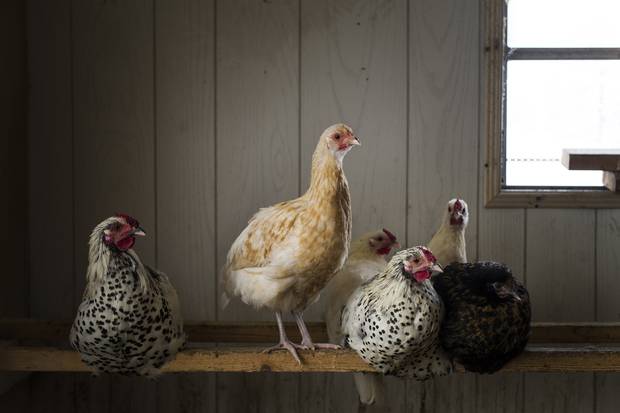
Murray Thunberg, a farmer near Cambridge, Ont., uses heritage breeds and time-honoured methods to produce eggs that are colourful but costly.
CHRISTOPHER KATSAROV FOR THE GLOBE AND MAIL
The high price of happy
And then there are those farmers whose methods don't fit neatly on a label. As a small-scale "pasture-raised" egg producer, Murray Thunberg provides one of the few remaining options for those who don't want to buy their eggs from a large commercial farm. But, because of supply management in the egg industry, he can afford to keep no more than 100 hens on his farm, near Cambridge, Ont. – meaning that his eggs are few, and hard for consumers to find.
For city dwellers whose only idea of farming comes from storybook images of Old MacDonald, Mr. Thunberg's 150-acre property, littered with red wooden "pig huts" (he also produces heritage pork), fits that picture almost perfectly – and it's no surprise that the bulk of his business is to high-end restaurants and gourmet butchers in Toronto. The hens live in a converted garage, and are free to wander outside most afternoons – given the Canadian climate, that's about as good as it gets. Because he has so few birds, overcrowding isn't an issue. (Large-scale cage-free farms can have fatal "pileups" – when a noise or even the presence of a visitor causes hens to stampede, trampling some to death in the process.)

Mr. Thunberg’s chickens mingle among the pigs.
CHRISTOPHER KATSAROV FOR THE GLOBE AND MAIL
Unlike big producers who normally select one breed based on productivity, Mr. Thunberg delights in diversity – he has a collection of rare and heritage breeds. He eases open his barn door to reveal a sea of colour: striking all-black Jersey Giants; golden Buff Orpingtons; Silver Pencilled Rocks, speckled black as well as silver.
He holds a bird with a grey-blue body and a caramel head: "Blue Copper Maran – these are the kind Martha Stewart has."
Mr. Thunberg walks toward a wall with rows of wooden cubbies, reaches under a hen nesting in one, and pulls out an egg. One by one, he works his way down the row, placing the eggs carefully in a wicker basket. A brown one, green, then blue.
For Mr. Thunberg, the recent science, like that of Dr. Mench's study, is not to be trusted. "Where's that science coming from?" he asks. He has been to caged farms, and says that "it just makes your heart sink when you see it."
So how does he know if his birds are happy?
Based on a feeling, he says.
"I've been around animals enough in my life that I can tell if an animal is in distress," he says. "It's who you are. Not everyone can do it, and do it right."
But there's a price for doing it right: Mr. Thunberg's eggs cost $8 to $9 a dozen.

Murray Thunberg relies on wicker, not tech, to collect his due. He also doubts science that says cages keep chickens safe. ‘Where’s that science coming from?’ he asks.
CHRISTOPHER KATSAROV FOR THE GLOBE AND MAIL
A free-range future?
Temple Grandin, meanwhile, has turned her attention to the future. "Okay, now we've got to make a cage-free system that works," she says with a shrug.
She may support furnished cages, but the industry has made its decision. She's a realist. "I try to bridge a lot of gaps … because we've got to figure out how to actually fix things."
Others are skeptical that the challenges with cage-free can be solved in time to meet the 10-year deadline set by companies like McDonald's, but Dr. Grandin is optimistic. "I've been in the design field for a long time, and I think the problems are solvable," she says. "It's amazing – necessity is the mother of invention."
Some issues, such as bone fractures, can be partly addressed through genetics and cage design, she explains. Others may require producers to compromise by reducing crowding – although that may lower production.
She draws the line, however, at the entire industry going free-range. "I don't think we can put every chicken outside," she says. "I don't think that's feasible."
ON THE FARM
Eggs served two ways: Furnished cages versus free-range chickens
by Ann Hui
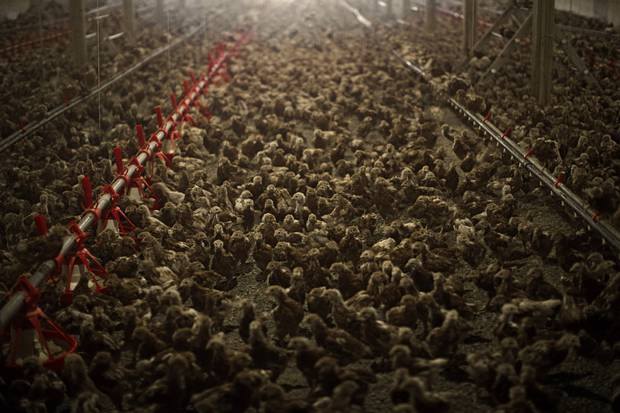
Ten thousand six-week-old chicks mill around in a barn at Twin Willows Enterprises in Chilliwack, B.C., which mass-produces eggs for Costco’s Kirkland organic line. To qualify as certified organic, eggs must come from chickens not kept in a cage.
RAFAL GERSZAK FOR THE GLOBE AND MAIL
The public perception of free-range eggs – and what's often depicted on the label – is an image of a bird stretching out its wings on a fresh grass pasture, bathing beneath a golden yellow sun with a red wooden barn in the background.
Reality looks a lot more like Twin Willows in Chilliwack, B.C.
Nestled amid hiking trails and the snow-capped mountains that surround the Fraser Valley, the farm is picturesque, but here there are no little red wooden barns – only grey, commercial-scale structures, gleaming electronic dashboards, and metal fixtures.
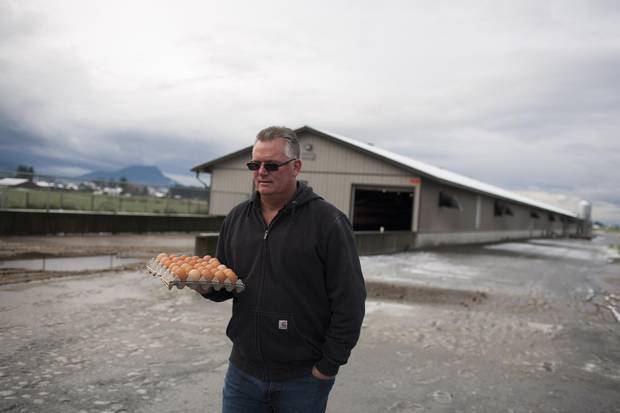
Rob Martens, with a tray of his free-range best, is no zealot: ‘If a caged farm was available, I would have bought that as well.’
RAFAL GERSZAK FOR THE GLOBE AND MAIL

Old manure is dumped from a barn at Twin Willows in preparation for new chickens.
RAFAL GERSZAK FOR THE GLOBE AND MAIL
For owner Rob Martens, egg farming is serious business: His 10,000 hens produce about 9,500 certified organic (and therefore free-range) eggs for Costco's Kirkland organic line each day.
Before he opens a barn door, Mr. Martens bangs on it – to warn the occupants that he's about to come inside.
He does the same before he leaves, in hopes of avoiding one of the biggest causes of mortality at his farm: pileups.

Chickens in the barn at Twin Willows.
RAFAL GERSZAK FOR THE GLOBE AND MAIL
Killer curiosity
"These chickens, they like following you around," he says. "They like it so much that, when you walk out … you'll hear them just piling against the door. And the next time you go in, there's two dead chickens because they've snuffed each other out. It's awful."
Inside the giant barn, the birds huddle together on the metal-grate floors, a sea of chocolate-coloured feathers.
When the weather allows it, Mr. Martens will ease open a small doorway, providing access to a field fenced off with wire, and more wire overheard to guard against predators.
He is proud of how his hens live, but he's no Old MacDonald. His decision to go cage-free has little to do with animal welfare. "It's simply because the farm was available. If a caged farm was available, I would've bought that as well," he says.
He calls cage-free "the trend of the day," but doubts the entire industry will switch. His eggs sell for no less than $6 a carton, and "there's only going to be a certain percentage of the population that's going to buy those."
In 2014, the average Canadian consumed more than 18 dozen eggs, and 90 per cent came from battery cages. "You have to realize people need to eat. I'm providing food for hundreds of thousands of people every day," he says. "I'm not doing this for a hobby. I'm doing this as a business."

Roger Pelissero mans the line: A few years ago, his family spent $2-million on better cages. Now, big buyers want no cages at all.
CHRISTOPHER KATSAROV FOR THE GLOBE AND MAIL
Playing cage catch-up
Roger Pelissero is also well aware of the economic realities of egg production – and what changes in public perception mean for it.
He has a 50-acre property in Ontario's Niagara Region. Toward the road, there is a large barn that was built when Mr. Pelissero's father took over the property in 1978. It once housed 15,000 hens in three long rows of battery cages. These days, all it's used for is storage.
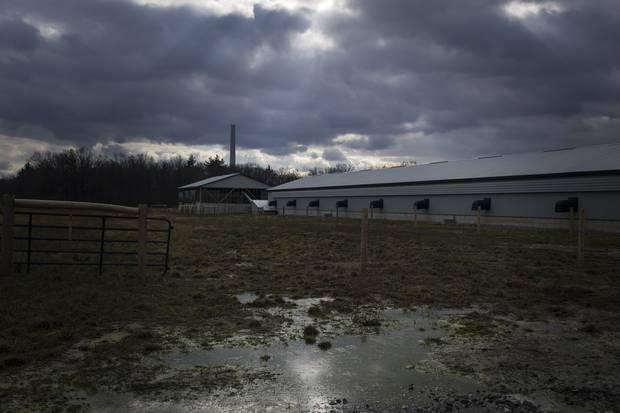
The Pelisseros’ farm property.
CHRISTOPHER KATSAROV FOR THE GLOBE AND MAIL
In 2013, Mr. Pelissero and his family decided to install furnished cages, which they saw as a compromise between the economic benefits of battery and the best interests of animal welfare. The transition cost $2-million – an investment they expect will take 20 years to pay off. The old cages were sold off as scrap metal.
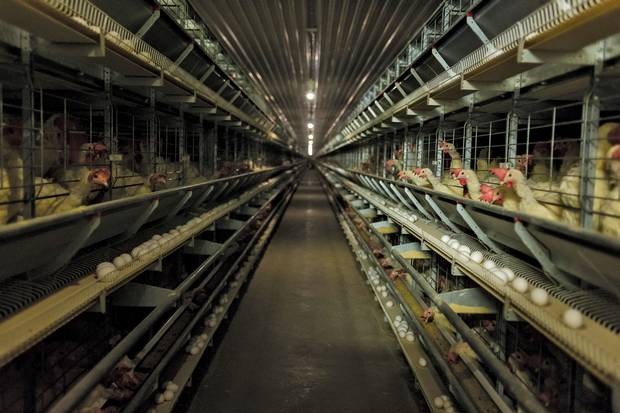
The German-build mechanized system not only houses thousands of chickens in ‘furnished’cages at the Pelissero family farm, it uses a network of conveyor belts to carry off their output for sorting.
CHRISTOPHER KATSAROV FOR THE GLOBE AND MAIL
The first thing guests notice when they walk into the new barn is the smell – inevitable, given the 17,000 hens living under a single roof.
Then there is the hulking machine: a German import called The Farmer Automatic that takes up almost the entire barn – a gleaming white, green and red network of cages that house the birds (which are lanky and white, with floppy red combs and quizzical expressions) and conveyor belts that cart away their eggs.
The cages don't offer complete protection. Some birds are missing feathers – the victims of aggressive hens, Mr. Pelissero says – with a few almost entirely bare around their necks. But the cages do provide room to walk about, a perch to hop up on, and a red plastic pad to scratch on and keep themselves occupied, though few appear interested in using it.
The hens live inside the machine, but they also power it – their eggs feeding the conveyor belts like coins in a slot machine. After a hen lays, her egg rolls down the sloped floor of the cage, out to a conveyor belt that carries it to an "elevator" that lifts it up and out of the room for sorting.
As for animal welfare, Mr. Pelissero says his best indicator is the fact that about 95 per cent of his birds produce every single day. "It's simple. All the hen wants to do is lay an egg. If my production is high, they're happy. If they're stressed out, production is low."
Ann Hui is The Globe and Mail's national food reporter.
An earlier version of this story incorrectly said there are 40 million eggs laid in Canada every year. In fact, there are 40 million boxes of eggs laid – equivalent to about 600 million dozen.
MORE READING: THE ETHICS OF WHAT YOU EAT
READ MORE FROM NATIONAL FOOD REPORTER ANN HUI







